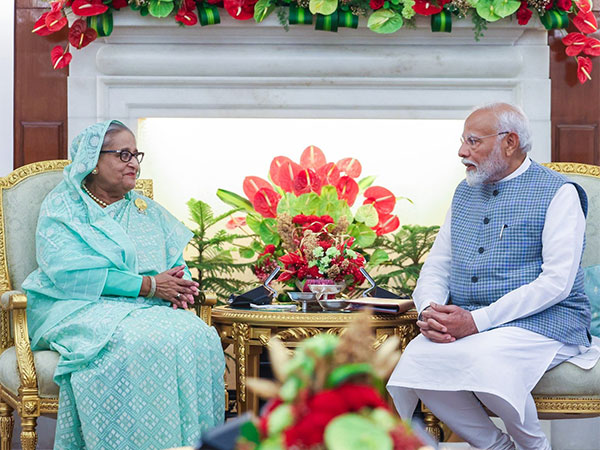
New Delhi: India and Bangladesh share a strong bond based on their common history, language, and culture. This relationship goes beyond just strategic cooperation; it’s rooted in equality, trust, and understanding.
Prime Minister Sheikh Hasina's visit to India (21-22 June 2024) is a much-discussed event in the political and economic arena of Bangladesh. This is the second visit of the Bangladesh Prime Minister after Narendra Modi formed the government for the third time.
The two countries discussed a number of issues, including easing of Indian visa, sharing of waters of all common rivers, including Teesta, and signing of a number of MoUs. During the visit, seven Memorandums of Understanding (MoUs) were signed which will further enhance cooperation in different fields between the two countries.
When it comes to trade, Bangladesh is India’s biggest trading partner in the subcontinent. In return, India is the second-largest export partner for Bangladesh, making up 12% of its total exports. In the fiscal year 2023, the total trade turnover between the two countries reached an impressive $14.22 billion. This economic collaboration highlights the deep connection and interdependence between India and Bangladesh, showcasing a partnership that extends beyond political ties.
Most Bangladeshi products have easy access to Indian markets although this is for now diluted by the difficulty in penetrating the vast but highly competitive Indian market. Indian goods are transshipped through Bangladesh to connect its eastern region with its far-eastern region using Bangladeshi transportation, literally a quid pro quo.
Connectivity has emerged as the key ingredient of strong India-Bangladesh relations. However, such connectivity was not limited to waterways, roads, and railways, which were particularly prominent in the pre-1947 era; it now included energy and digital connectivity.
Looking at the current state of cooperation between Bangladesh and India and the drive for infrastructural development of both countries, one can see the prospects of connectivity at three levels. Firstly, India’s push for connectivity coincides with Bangladesh’s interest in a more significant relationship with northeast India.
Cross-border buses operate along five different border routes connecting India’s States of Assam, Meghalaya, Tripura, and West Bengal with Bangladesh, and Bangladesh has also undertaken projects with India targeting the northeastern states of the latter, including the Matabari deep seaport.
The seaport is destined to facilitate the exports and imports of northeastern states, with Bangladesh benefiting from the transactions of goods and raw materials. In this context, the Akhaura-Agartala cross-border rail link would play a vital role, as would the Khulna-Mongla port rail line, the agreements of which were signed between the two countries in November 2023.
To counter India’s immense popularity in Bangladesh, China has expressed interest to invest in the Teesta project. This changed stance is a fallout of new geopolitical realities. It is difficult to erase the fact that China aligned with Pakistan, its all-weather friend, and opposed Bangladesh’s independence during the 1971 liberation war.
Pakistan’s ally China still remains the former close Iron brother. India on the other hand has long been at the centre of Bangladesh’s foreign policy, due to its historical, cultural, geographic proximity, security links and above all its intervention as an ally against Pakistan during Bangladesh’s liberation war
Unlike the Bangladesh-India economic cooperation, China’s economic footprint in Bangladesh is relatively new. And in this too the defence cooperation is the main component of the relationship. In an effort to gain ground in Bangladesh, China is engaged in fierce investment, luring Dhaka.
Bangladesh has a growing trade imbalance with China which is a major problem because it is inconceivable that Bangladesh will ever be able to cut its trade gap with the world’s factory; ultimately harming the economy.
Given the unique cooperation, it is no wonder that India decided, in contradistinction to the United States and some European countries, not to interfere in the internal affairs of Bangladesh, and preferring to look only with interest Bangladesh’s national election on 7 January 2024.
This prompted the United States and several European countries to abandon their earlier path of pressuring the government to heed the opposition’s demands to create conditions for its election participation. Instead, they opted for a course correction immediately after the election. They welcomed the new government led by the ruling party, lest they become isolated and further alienate Bangladesh from them.
Bangladesh and India have forged a unique collaboration in security matters, which makes Bangladesh vital to India for ensuring its security. At the same time, India remains essential to Bangladesh for safeguarding its security from regional and extra-regional threats.
Over the years, Bangladesh has created its identity as a pragmatic power. Its political leadership has a clear vision of its social, economic and political priorities and hence seeks to continuously expand on its ties with India in various fields of development-an idea which is amply reflected in the Indo-Pacific Outlook. India’s approach towards geopolitics can be visualised in concentric circles, where the neighbourhood is the innermost circle guided by its Act East and Neighbourhood First Policy, gradually moving on to the extended neighbourhood and then the wider Indo-Pacific. Connectivity, trade, infrastructure and capacity building are constant features of India’s engagements in the Indo-Pacific. The country deems such ties as important not just from the security perspective but mainly for mutual development- as is manifested in its relation with Bangladesh.
Bangladesh’s foreign policy calculations towards China represent ‘realpolitik' , powered primarily by economic incentives. But in India, Bangladesh has a traditional regional partner, a true friend that has shared the same colonial history, whose people share bonds of family and that share similar problems of developing and nation-building.
_________________________________________________________